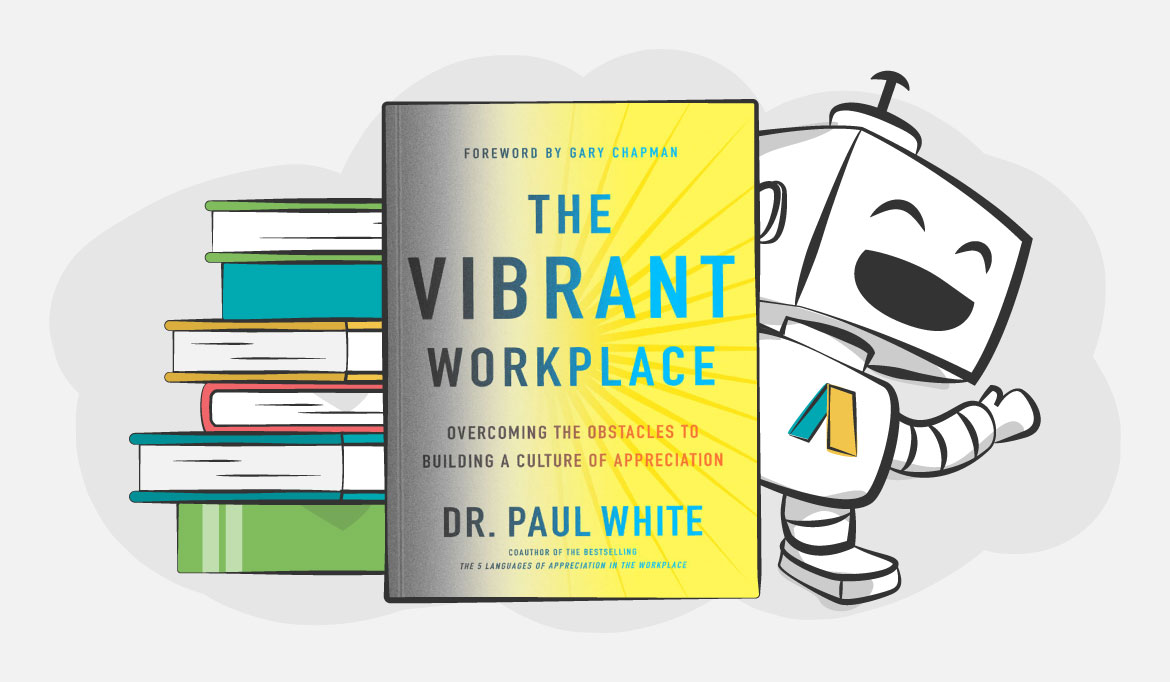MONTHLY NEWSLETTER:
Subscribe and join our community of curious HR Professionals and Managers.
Latest Article
Categories
Quick Links
Applauz Blog
Published: August 4, 2020
Last Updated: February 7, 2024
5 min read
By: Michelle Cadieux

In this instalment of Applauz Book Club, we will cover a summary of The Vibrant Workplace by Dr. Paul White.
📖 Applauz Book Club is a series that outlines noteworthy ideas from popular books on the topics of work, HR strategy, and management.
Gratitude and respect are the bedrock of all healthy relationships. This is true in our personal lives and at work.
That's why employee recognition is a central element of any employee engagement strategy.
For this reason, many companies put in place recognition programs for their businesses.
Human resource experts estimate 90% of all companies have some type of employee recognition program in place.
Recognition programs are more widespread than ever. But employee engagement and job satisfaction levels have declined over the same period!
The Vibrant Workplace: Overcoming the Obstacles to Building a Culture of Appreciation, explores the question of why many businesses struggle with recognition.
The 2017 book is written by Dr. Paul White, a psychologist and leading workplace authority. In this book, White unpacks the obstacles holding organizations back from experiencing a positive, vibrant workplace.

This article will provide a summary of the key ideas from The Vibrant Workplace. These ideas will help you understand and answer some of the following questions:
Whether you're looking to implement a recognition program in your organization or already have one in place, these ideas will help navigate the obstacles preventing your program from flourishing.
 3 Misconceptions Leaders Have About Appreciation
3 Misconceptions Leaders Have About AppreciationIf you surveyed your company's employees and asked them if they felt appreciated at work, what do you think they would say?
In the author's research, they found that 51% of managers felt they offered employees genuine recognition. But only 17% of the employees who worked for those managers felt appreciated.
Why the disconnect?
White discovered that many leaders hold false beliefs about appreciation; these misconceptions may be inadvertently thwarting their efforts.
1- Money is the number one motivator
Many leaders believe money is the ultimate currency of appreciation. In other words, if you pay your employees, they shouldn't need extra validation or appreciation.
In The Vibrant Workplace, White insists this idea couldn't be more false.
Several psychological studies show that money is an ineffective long-term motivator for many people.
This doesn't imply wages are irrelevant to employee motivation; offering your employees fair pay is a basic necessity. But leaders who believe money is the sole employee motivator are more likely to neglect employee recognition.
The lesson: for a recognition program to work, leaders must truly believe in the power of gratitude and appreciation at work.
2- The primary goal of communicating appreciation is to make employees happy
White argues that attempting to make others happy is an “endeavour doomed to fail.” He explains that happiness results from the positive habits we build in our lives; the only person who has power over that is the individual themselves.
When leaders believe this idea, they set themselves up for frustration and, ultimately, failure. Happiness is a moving target; it cannot be obtained by performing a single action.
Rather than focusing on an elusive end goal, like happiness, recognition programs should be about building a pleasant, engaging work environment for everyone.
3- The primary purpose of appreciation is to increase productivity
In the same vein, White highlights an important final point. When financial factors are the end goal of a program, it undermines the entire system.
When employees think management uses recognition to increase productivity and profits, it produces an atmosphere of distrust.
This cynicism leads to a decay of faith in the program. As a result, generic praise and recognition are exchanged as a performance to "go through the motions."
Giving recognition is not a transaction. For White, performative appreciation will damage a recognition program in the long term.
For recognition programs to succeed, they cannot be viewed as an instrument to meet an end goal like happiness, productivity, and profit. The only outcome managers should expect from recognition is the momentary, positive feelings that arise from the interaction.
Managers might think: if those feelings are momentary, why bother?
Leaders must understand that when it comes to appreciation, small and consistent always beat big and occasionally.
In other words, it's the little things that, when done repeatedly, add up over time to make the longest-lasting impressions on relationships, and most importantly, on your entire organizational culture.
As White puts it, "appreciation for colleagues communicates respect and value for them."
Bottom line: Appreciation is about seeing someone for the value they bring to the team, not just acknowledging their output. Employees don't want to be viewed as "work units" whose value is only derived from how much they produced. Instead, appreciation should be about recognizing your employees as people with unique abilities, personalities, and talents.
 Why Recognition Programs are Viewed as Inauthentic
Why Recognition Programs are Viewed as InauthenticWhen leaders and, in extension, employees fall victim to these misconceptions and ignore the “true purpose” of appreciation, it breeds an attitude of cynicism towards recognition programs. As a result, employees view recognition as fake and inauthentic.
White believes when employees are wary of recognition, it's because "people have not been communicated with genuine appreciation."
So what causes employees to view recognition as disingenuous, in other words, inauthentic?
Obligatory: When companies command everyone to participate in a recognition program, this creates an environment where employees see praise as feigned because it's mandatory.
Organizationally driven: Recognition holds less weight when it only comes from an individual so high up they don't have a direct relationship with the employees on the receiving end.
Impersonal: When recognition is generic like "way to go, team," it says nothing about what the people did differently to get the job done. As a result, employees perceive it as inauthentic.
Generic: When everyone in the company receives identical letters at Christmas with the same impersonal gift card, employees see it as generic, and therefore, inauthentic.
Over-reliance on tangible rewards: When businesses rely only on generic, low-cost tangible rewards (with no words of recognition), employees perceive the gesture as inauthentic.
 Best Practices to Create a Lasting Recognition Program that Works
Best Practices to Create a Lasting Recognition Program that WorksFor White, the key to ensuring employees experience recognition as authentic boils down to sincerity.
He lists some suggestions for managers to follow if they want to ensure employees experience recognition as sincere and authentic.
Only communicate appreciation when it's true: Don't recognize to "go through the motions" only offer recognition when you feel an employee genuinely deserves it.
Acknowledge the barriers: When you acknowledge the difficulties and hurdles to genuine recognition, it reveals vulnerability and disarms people. As a result, your recognition message will be seen as honest and sincere.
Be specific: Be very specific about the person you want to appreciate. People want to feel special. As such, words of appreciation should be personal; acknowledge the value that the employee brings outside of their work, such as their interests, passions, and personality.
Be consistent over time: When you communicate appreciation, only a handful of times a year, it will be perceived as disingenuous. Make an effort to weave gratitude and appreciation into your regular workflow, every day. That way, it won't be seen as just another thing you checked off your to-do list.
Praise performance or situations that don’t benefit you directly: Employees are wary of managers who give appreciation only when they deliver something that benefits them or the bottom line. Instead, try praising employees for all types of actions; point out their unique personality, accomplishments, and talents outside their professional lives.
A deep culture of recognition does not grow out of a traditional top-down approach. In other words, companies with strong recognition programs see recognition as a value everyone lives by, rather than an action only managers take a few times a year.
A sign your recognition culture is growing is when managers start to offer gratitude outside of the official program. You will also notice peers begin to praise and thank each other more often. And employees will even recognize their managers!
Ultimately, recognition will become a fun, regular part of everyone's daily interactions, and not an enforced top-down process. That's when you know your recognition program has truly flourished.

MONTHLY NEWSLETTER:
Subscribe and join our community of curious HR Professionals and Managers.

7675 Blvd Saint-Laurent,
suite 201,
Montreal, QC,
CA, H2R 1W9
7675 Blvd Saint-Laurent, suite 201, Montreal, QC, CA, H2R 1W9
Contact us
1 833 277 5289
Contact us | 1 833 277 5289
Follow us on LinkedIn:
© Copyright 2024. All Rights Reserved